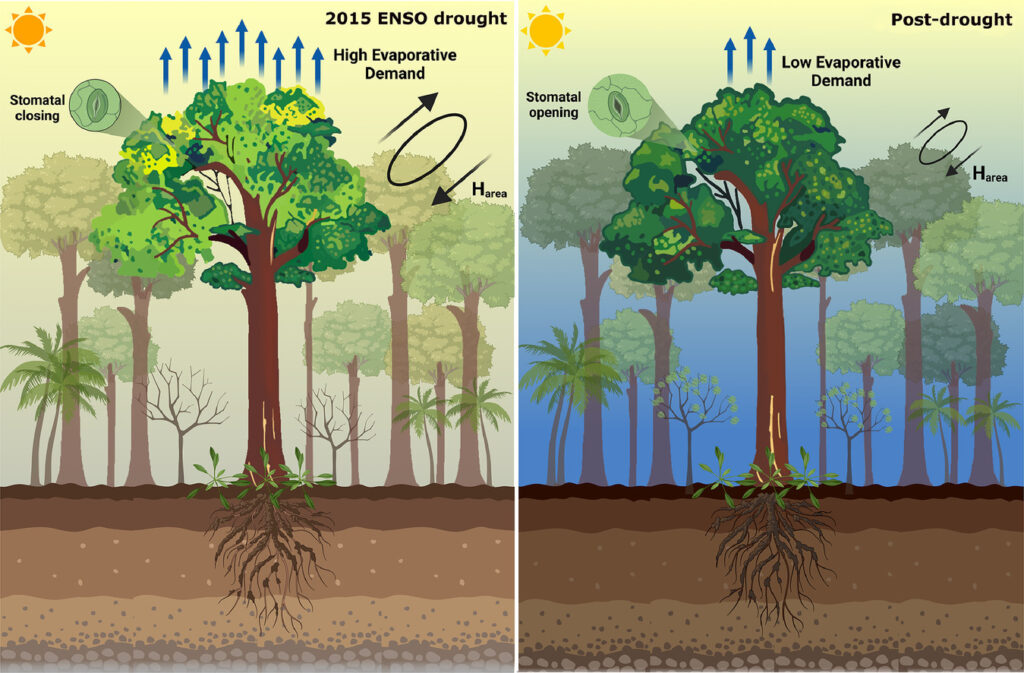The changes in hysteresis area during the 2015 ENSO drought compared to the post-drought period highlight the risk of hydraulic failure of tropical species under extreme heat stress.

Canopy-level transpiration during the 2015 ENSO-driven drought in the Central Amazon exhibited significant deviations due to exceptionally high Vapor Pressure Deficit (VPD) conditions and increased temporal differences between the peaks of stomatal conductance (gs) and VPD. This resulted in an increased hysteresis effect, as evidenced by the expanded hysteresis area (Harea) across multiple ecophysiological variables compared to the post-drought period. Image courtesy of authors.
The Science
During the 2015 ENSO-driven drought in the Central Amazon, canopy-level transpiration exhibited significant deviations due to exceptionally high Vapor Pressure Deficit (VPD) conditions and increased temporal differences between the peaks of stomatal conductance (gs) and VPD. This resulted in an increased hysteresis effect, as evidenced by the expanded hysteresis area (Harea) across multiple ecophysiological variables compared to the post-drought period.
These canopy-level observations were developed using two distinct methods due to the difficulty of accessing canopy layers in the Amazon forest. First, species selection was determined by the proximity of the tree crown to the K-34 flux tower. The K-34 tower provided access to the crowns of a few species for leaf-level measurements. Additionally, we conducted leaf gas exchange experiments using, for the first time in the Amazon forest, a 26.0 m telescopic boom lift (Genie® Z-80/60) to access the canopy of multiple species.
The Impact
There are several challenges to performing in situ observations at the canopy level in tropical ecosystems such as the Amazon forest. This difficulty in conducting leaf-level measurements in the tropics is being overcome by the use of towers, climbing techniques, canopy walkways, canopy-access cranes (e.g., Panama and Daintree Forest in Australia), and, for the first time in the Amazon forest, a telescopic boom lift (“cherry picker”) used as reported by this study (Manaus, ZF-2). This significant effort in the Amazon forest has provided new insights into leaf gas exchange processes and the access of multiple species at different canopy levels. From this perspective, understanding the patterns of stomatal conductance and leaf water potential across a range of species, along with canopy temperature and vapor pressure deficit measurements as demonstrated by this study, is crucial for improving the climate models in the 21st century such as FATES, especially during extreme drought events.
Summary
Understanding forest water limitation during droughts within a warming climate is essential for accurate predictions of forest-climate interactions. In hyperdiverse ecosystems like the Amazon forest, the mechanisms shaping hysteresis patterns in transpiration relative to environmental factors are not well understood. From this perspective, we investigated these dynamics by conducting in situ leaf-level measurements throughout and after the 2015 El Niño-Southern Oscillation (ENSO) drought. Our findings indicate a substantial increase in the hysteresis area (Harea) among transpiration (E), vapor pressure deficit (VPD), and stomatal conductance (gs) at canopy level during the ENSO peak, attributed to both temporal lag and differences in magnitude between gs and VPD peaks. Specifically, the canopy species Pouteria anomala exhibited an increased Harea, due to earlier maximum gs rates leading to a greater temporal lag with VPD compared to the post-drought period. Additionally, leaf water potential (ΨL) and canopy temperature (Tcanopy) showed larger Harea during the ENSO peak compared to post-drought conditions across all studied species, suggesting that stomatal closure, particularly during the afternoon, acts to minimize water loss and may explain the counterclockwise hysteresis observed between ΨL and Tcanopy. The pronounced Harea during the drought points to a potential imbalance between water supply and demand, underlining the role of stomatal behavior of isohydric species in response to drought.
Contact
Bruno O. Gimenez
University of California – Berkeley (UCB)
b_gimenez@berkeley.edu
Funding
This work is based upon work supported as part of the Next Generation Ecosystem Experiments-Tropics (NGEE-Tropics), as part of DOE’s Terrestrial Ecosystem Science Program – Contract No. DE-AC02–05CH11231. Additional funding for this research was provided by the Coordenação de Aperfeiçoamento de Pessoal de Nível Superior (CAPES), INCT – Madeiras da Amazônia, Conselho Nacional de Desenvolvimento Científico e Tecnológico (CNPq) – Processo: 403839/2021-1 Chamada CNPq/MCTI/FNDCT Nº 18/2021 – Faixa A – Grupos Emergentes Universal 2021, and Fundação de Amparo à Pesquisa do Estado do Amazonas (FAPEAM).
Publications
Gimenez, B. O., Souza, D. C., Higuchi, N., Negrón-Juárez, R. I., de Jesus Sampaio-Filho, I., Araújo, A. C., … & Chambers, J. Q. (2024). “Hysteresis area at the canopy level during and after a drought event in the Central Amazon” Agricultural and Forest Meteorology, 353, 110052. https://doi.org/10.1016/j.agrformet.2024.110052